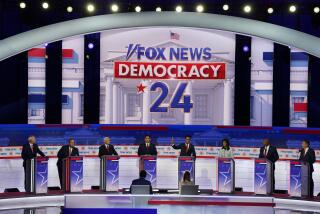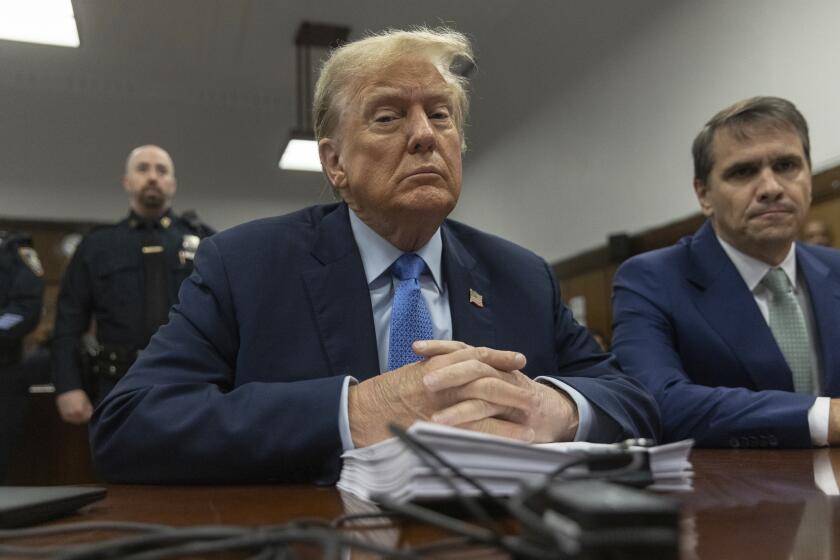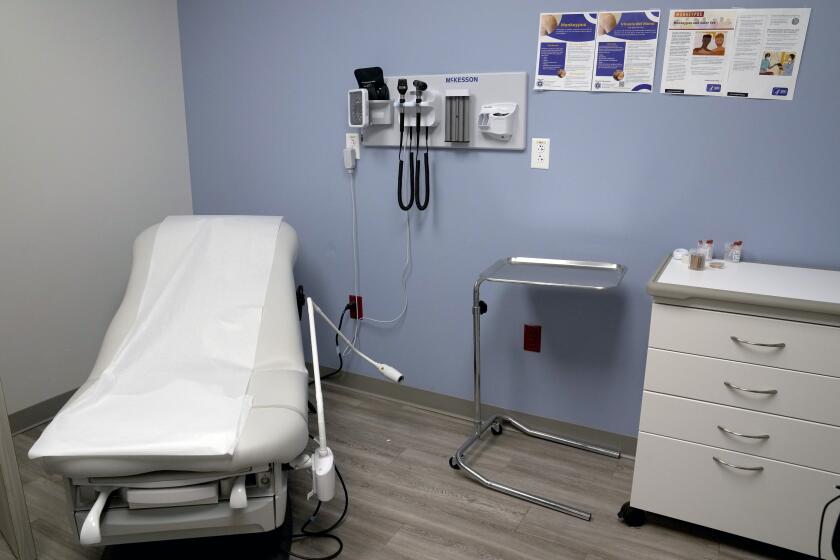Essential Politics: The beginning of the end for Trump?
If Donald Trump loses the 2016 election, this past week may be the one chroniclers identify as the time his quest irretrievably headed downhill.
Yes, nearly five months remain until the election, much can happen and Trump has amply proved his ability to seize a moment. Just as he’s risen before, Trump could rise again.
But right now, Trump has set himself on a losing path, and it’s worth looking back at why and how.
Good afternoon, I’m David Lauter, Washington bureau chief. Welcome to the Friday edition of our Essential Politics newsletter, in which we look at the events of the week in the presidential campaign and highlight some particularly insightful stories.
WHY TRUMP IS IN TROUBLE
In an article Thursday, I ran through the polling evidence of Trump’s decline. His problems are stark and manifold:
As Lisa Mascaro reported, his attacks earlier this month on Gonzalo Curiel, the federal district judge handling the civil suit against Trump University, revived Republican leaders’ fears that Trump could alienate Latino voters for a generation. As they distanced themselves from Trump, Republican leaders like House Speaker Paul Ryan validated Democratic attacks on his stability and deepened the doubts of Republican voters who had not supported Trump in the primaries.
Democrats have started to unify behind Hillary Clinton. She currently holds about a five-point lead over Trump in polling averages — slightly larger than the margin by which President Obama defeated Mitt Romney in 2012 — and her support has further room to grow if more of Sen. Bernie Sanders’ backers come over to her side, which history suggests many will do.
The vastly disproportionate level of coverage that Trump benefited from during the primaries — a new study from Harvard’s Shorenstein Center documented how much — no longer is assisting him in the general election.
Finally, Trump’s characteristic response to events — seize the moment and go on the attack — which served him so well during the GOP primaries, appears to have backfired in the aftermath of the mass shooting in Orlando last weekend. As Evan Halper wrote, the responses by Clinton, President Obama and Trump tested the new norms for American politics. So far, the two Democrats, who escalated their attacks on Trump during the week, appear to have passed the test, while Trump has not.
It’s not clear that Trump can adopt a more modest rhetorical style — and even less clear that he would retain the ardent loyalty of his fans if he did so. They like him the way he is, as Mascaro reported from his Southern rallies this week.
None of that means the election is over. Even as voters say they’re likely to side with Clinton, many don’t trust her; economic growth remains tepid at best; and the Democrats are trying to win the White House for a third consecutive election, which is a rare feat.
But as Clinton begins an advertising barrage in eight battleground states — something the Trump campaign currently lacks the money to match — she is clearly playing from a position of strength. Those eight states hold 100 electoral votes; Clinton would need to get only 23 of them to win the presidency, assuming she holds the other states that Obama won twice.
BERNIE BOWS OUT — SORT OF
Meantime, on the Democratic side, the dance between the Sanders and Clinton camps continues to play out.
In statements Tuesday, which Mike Memoli wrote about, and in his video message to supporters Thursday night, Sanders hinted at a new role, but said nothing to formally acknowledge that he had lost the race to Clinton. Odds are he won’t actually say so in public until the two sides reach an agreement over the party platform: A formal endorsement is the leverage he has in those negotiations.
But as Cathy Decker noted, Sanders’ leverage is a dwindling asset. The more Trump struggles, the less the Clinton camp will be inclined to concede to the Vermont senator.
For a great analysis of what Sanders accomplished, and why he fell short, check out this piece by Mark Z. Barabak.
POLLS — WE GOT ’EM
Our preelection poll with USC of California voters found Clinton up by 10 points among likely voters. As of today, with the count almost complete, Clinton’s lead stands at 10.5 percentage points.
The poll also asked about California voters’ views on healthcare and found that costs are the top issue, outpacing concerns about having insurance.
The Times and USC also conducted a post-election poll to analyze how Clinton put together her victory. Read Decker’s excellent analysis of the results.
As Decker also reported, the post-election poll shows California Atty. Gen. Kamala Harris in strong position to win election as California’s next senator. Her challenger in the all-Democratic runoff in November, Rep. Loretta Sanchez, has a steep hill ahead of her.
TRUMP AND THE TRIBES
Noah Bierman and Joe Tanfani have a fascinating story on Trump’s dealings over the years with Native American tribes. His rhetoric of insults, many racially tinged, and denunciations of “political correctness” go back decades and preview much of what we’ve seen in the campaign.
THE LIBERTARIAN MOMENT
One person’s problem is another’s opportunity. Right now, the Libertarian party hopes that Trump’s difficulties will boost their chances. It’s a very long shot, but as Melanie Mason reported from Utah, there are some states where GOP antipathy toward Trump may give the Libertarians a significant opening.
LOGISTICS
If you like this newsletter, tell your friends to sign up.
That wraps up this week. My colleague Christina Bellantoni will be back Monday with the weekday edition of Essential Politics. Until then, keep track of all the developments in the 2016 campaign with our Trail Guide, at our Politics page and on Twitter @latimespolitics.
Send your comments, suggestions and news tips to politics@latimes.com.
Did someone forward you this? Sign up here to get Essential Politics in your inbox daily.
More to Read
Get the L.A. Times Politics newsletter
Deeply reported insights into legislation, politics and policy from Sacramento, Washington and beyond. In your inbox three times per week.
You may occasionally receive promotional content from the Los Angeles Times.






